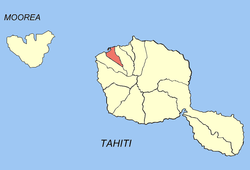
Back Papeete Afrikaans Pahpētig ANG بابيتي Arabic Papeete AST Papeete Azerbaijani Папеэтэ Byelorussian Папээтэ BE-X-OLD Папеете Bulgarian Pape‘ete Breton Papeete BS
Papeʻetē | |
|---|---|
|
Top: aerial view of Pape'etē; middle: Cathedral of Notre Dame of Papeʻetē, Presidential palace; bottom: Pape'etēTown Hall, Bougainville Park | |
 Location of the commune (in red) within the Windward Islands | |
| Coordinates: 17°32′06″S 149°34′11″W / 17.535°S 149.5696°W | |
| Country | France |
| Overseas collectivity | French Polynesia |
| Subdivision | Windward Islands |
| Government | |
| • Mayor (2020–2026) | Michel Buillard[1] |
Area 1[2] | 17.4 km2 (6.7 sq mi) |
| • Urban | 299.5 km2 (115.6 sq mi) |
| Population (2022)[3] | 26,654 |
| • Density | 1,500/km2 (4,000/sq mi) |
| • Urban | 124,274 |
| • Urban density | 410/km2 (1,100/sq mi) |
| Time zone | UTC−10:00 |
| INSEE/Postal code | 98735 /98714 |
| Elevation | 0–621 m (0–2,037 ft) |
| 1 French Land Register data, which excludes lakes, ponds, glaciers > 1 km2 (0.386 sq mi or 247 acres) and river estuaries. | |
Papeete (Tahitian: Papeʻete, pronounced [pa.pe.ʔe.te]; old name: Vaiʻete[4]) is the capital city of French Polynesia, an overseas collectivity of the French Republic in the Pacific Ocean. The commune of Papeete is located on the island of Tahiti, in the administrative subdivision of the Windward Islands, of which Papeete is the administrative capital.[5] Both the President of French Polynesia and French High Commissioner reside in Papeete.[6]
It is the primary center of Tahitian and French Polynesian public and private governmental, commercial, industrial, and financial services, the hub of French Polynesian tourism and a commonly used port of call.[6] The Windward Islands are themselves part of the Society Islands. The name Papeʻetē,[Note 1] means "water from a basket"[7]— this was an effect of a naming taboo during Pōmare I's reign where the Tahitian contemporary word for water vai was substituted with pape,[8] the old name Vaiʻetē is still recognised in some areas such as the Marquesas.[4] The urban area of Papeʻetē had a total population of 124,724 inhabitants at the 2022 census, 26,654 of whom lived in the commune of Papeʻetē proper.[3]
- ^ "Répertoire national des élus: les maires" (in French). data.gouv.fr, Plateforme ouverte des données publiques françaises. 13 September 2022.
- ^ "R1- Population sans doubles comptes, des subdivisions, communes et communes associées de Polynésie française, de 1971 à 1996". ISPF. Archived from the original on 2012-11-14. Retrieved 2019-03-14.
- ^ a b "Les résultats du recensement de la population 2022 de Polynésie française" [Results of the 2022 population census of French Polynesia] (PDF) (in French). Institut de la statistique de la Polynésie française. January 2023.
- ^ a b Personal communication with Michael Koch in Schütz, Albert J. (2020). Hawaiian language: past, present, and future: what every teacher and student of Hawaiian might like to know about the history and future of the language. Honolulu: University of Hawai'i. p. 5. ISBN 9780824869830.
- ^ Décret n° 2005-1611 du 20 décembre 2005 pris pour l'application du statut d'autonomie de la Polynésie française Archived 2019-03-27 at the Wayback Machine, Légifrance
- ^ a b Kay, p. 106
- ^ Kay, p. 102.
- ^ White, Ralph Gardner (1968). "Borrowing and Taboo in Eastern Polynesia". The Journal of the Polynesian Society. 77 (1): 64–5. ISSN 0032-4000. JSTOR 20704526.
Cite error: There are <ref group=Note> tags on this page, but the references will not show without a {{reflist|group=Note}} template (see the help page).





